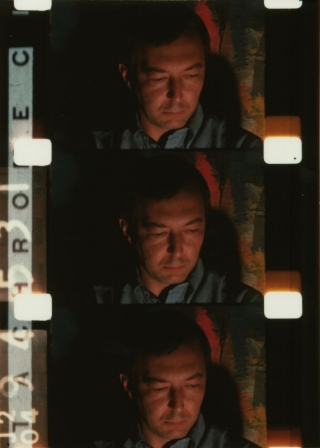Date: 18 April 2004 | Season: Gregory Markopoulos 2004 | Tags: Gregory Markopoulos, Markopoulos
PORTRAITURE
Sunday 18 April 2004, at 6.20pm
London National Film Theatre NFT2
Galaxie consists of thirty-three portraits of important figures from the art world, including painters, poets, critics, filmmakers, and choreographers. Each is shot with a single roll of 16mm film and though edited entirely in-camera, often comprises of many layers of dense superimposition. The subjects were invited to pose in their home, together with objects chosen by them as symbolic extensions of their personality. Saint Actaeon is a rhythmic portrait of historian and aesthete Sir Harold Acton, shot in the gardens of his family villa.
Gregory Markopoulos, Galaxie, USA, 1966, 92 min
Gregory Markopoulos, Saint Actaeon, Italy, 1971, 12 min
The programme will be introduced by Robert Beavers, filmmaker and director of Temenos Inc.
Also Screening: Wednesday 21 April 2004, at 6.20pm, NFT2
PROGRAMME NOTES
PORTRAITURE
Sunday 18 April 2004, at 6.20pm
London National Film Theatre NFT2
GALAXIE
Gregory Markopoulos, USA, 1966, 16mm, colour, sound, 92 min
SAINT ACTAEON
Gregory Markopoulos, Italy, 1971, colour, silent, 12 min
The work of Gregory Markopoulos occupies a unique position in the history of film. He is widely regarded as one of the masters of the cinematic art, yet since he departed the United States in 1967 his films were almost impossible to see. As a result of his need for total control over the presentation of his vision, he increasingly withdrew himself and his films from the film community he had been so actively involved in up to that point.
In 1964, he began work on the film which would eventually become The Illiac Passion (1967). During the period in which he was editing and securing funding for that film, he made three films edited entirely in-camera. Ming Green (1966) is an immaculately constructed portrait of his apartment that was shot in a single afternoon. Through a Lens Brightly: Mark Turbyfill (1967) is a biographical portrait of the dancer and poet. A veritable who’s who of the art world in the mid-1960s, Galaxie includes portraits of 33 painters, poets, critics, filmmakers, and choreographers. Shooting with his Bolex camera and utilising an intricate system he developed that allowed for multiple images and for editing the entire work in-camera, Markopoulos created elaborate portraits of such seminal figures as W.H. Auden, Jasper Johns, Erick Hawkins, and Susan Sontag.
‘The filmmaker resurrected the discipline of making films without post-editing in 1966 when he shot his collection of portraits, Galaxie. In making the portraits his method had been to select an object or an activity with personal significance to the subject. Carefully watching the frame-counter on his camera, he would expose a number of takes of one image interspersed with blackness. He would then rewind the film and expose the units of the next view, detail, or object. Each image has its own metrical pace, which alternates with or is superimposed upon the others.’ (P. Adams Sitney)
Throughout the 1980s, Markopoulos also worked on the Eniaios (1948-91), a series of 22 silent film cycles containing material from his 40 years as a filmmaker. The series was fully edited, but not printed, before his death in 1992. It consists of over 80 hours of film and will cost an estimated $800,000 to complete. Robert Beavers is continuing to pursue the construction of the Temenos, and intends to build an archive for Markopoulos’ journals, letters, script, articles and reviews which the filmmaker had linen-bound in handmade cases and are currently stored in a Swiss vault, together with a film theatre for presentation of the complete Eniaios. To date, four of the cycles, thirteen hours in total, have been preserved and printed.
In recent years the films of Markopoulos have been gradually reintroduced to the viewing public and have been honoured at major museums and festivals, including retrospectives at the American Centre (Paris 1995), The Whitney Museum of American Art (New York 1996), Pacific Film Archive (San Francisco 1997) The Film Society of Lincoln Centre (New York 2003) and Harvard Film Archive (2003). In May 2003, Robert Beavers and Simon Field presented a screening of Markopoulos films at the Goethe Institute, Athens, to an audience exceeding 350 people, and in June 2004, Temenos Inc. will resume the summer screening programme at the outdoor site in Lyssaraia.
This National Film Theatre season is the first time that so many of the films of Markopoulos have been shown in England on such a scale. Since he withdrew his films from exhibition in the early 1970s, they have been virtually impossible to see in the UK. This high-profile event will also act as a precursor to the resumption of outdoor Temenos projections at a remote site near Arcadia in the Peloponnese in June 2004, where restored films from the epic Eniaios cycle will be presented in public the first time. For three consecutive nights, screenings will take place from 10pm to 4am in the place chosen by Markopoulos as the ideal site for a spectator’s quest, in which his films may elevate the spectators’ sense of time while emotionally and physically connecting them to the mythic themes and locations.
(Mark Webber)
Back to top
